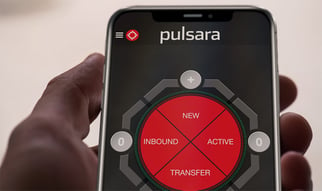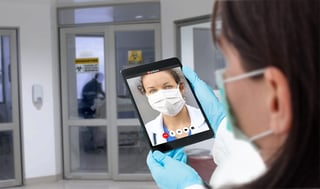Pulsara Around the World - 2025 Recap and January 2026
December Recap After an incredibly busy events year with 102 conferences, trade shows, and sponsorships, December was on the slower side for us, with...
3 min read
 Team Pulsara
:
Jun 01, 2020
Team Pulsara
:
Jun 01, 2020

Editor's Note: This week, The Tech Tribune released an exclusive Q&A with Pulsara's Founder and CEO, Dr. James Woodson. Pulsara has been featured in The Tech Tribune's 2018 Best Tech Startups in Montana, 2019 Best Tech Startups in Bozeman, 2019 Best Tech Startups in Montana, 2020 Best Tech Startups in Bozeman, and 2020 Best Tech Startups in Montana. Check out the full interview here.
—
 Imagine yourself back in 2012. You are watching mobile technology take off and disruptive platform business models solve complex problems in almost every industry. At the same time, you are living in the healthcare industry that still relies on fax, phones, radios, and pagers when you are trying to take care of heart attack or other critically ill patients.
Imagine yourself back in 2012. You are watching mobile technology take off and disruptive platform business models solve complex problems in almost every industry. At the same time, you are living in the healthcare industry that still relies on fax, phones, radios, and pagers when you are trying to take care of heart attack or other critically ill patients.
Every month I would sit on System of Care committees where we would analyze breakdowns in our system that caused adverse patient events, treatment delays, and costly operational failures. We would try to put more policies in place, but it was an infrastructure problem. We needed a communication and telehealth platform that could connect care teams, even ACROSS organizations.
If Amazon can align buyers, sellers, financial institutions, and logistics companies in a very simple interaction that can be done on my smartphone in seconds, why can’t we unite care teams around a patient event? So much effort was being put toward uniting data (interoperability of the Electronic Health Record) that everyone forgot to unite the PEOPLE providing care to individual patients and we were left playing the telephone game when time and clarity are critical.
While switching careers from a practicing emergency physician and to running a healthcare technology business was a big transition, I was blessed with amazing people that protected the company and me from making a lot of rookie mistakes. Therefore, for me, the biggest hurdle that I underestimated was the burden of being a “Category Creator.”
Disruptive Innovation sounds really cool until you are the one doing it!

When we talked to clinicians, there was overwhelming support so, like most entrepreneurs, I felt like the innovation diffusion curve applied only to other people. We not only had to educate the market as to the need, but there was not a line item in our customers’ budgets set aside for purchasing something like Pulsara. While healthcare was starting to purchase some cloud based SaaS solutions, most of their existing solutions were on premise and their privacy and security policies did not even apply to solutions like ours.
Even though clinicians were using mobile technology against their employers’ policies because it was the right thing to do for the patient (and much easier), healthcare organizations were struggling with officially adopting mobile technology. In many cases, the unofficial policy was to prohibit it, but turn a blind eye to its use. Finally, we deployed a platform business model that was poorly understood by many in healthcare – they did not understand why we subsidized producers (our freemium product) and thought there must be a gotcha clause somewhere.
We now find ourselves in a very favorable position in that the healthcare industry has finally caught up, we are light years ahead of others in this space, COVID-19 has highlighted the need for team communication across organizations, we have proven that we can rapidly scale (grew 33% in a 10 week period), CMS has unleashed telehealth with relaxed regulatory/new reimbursement policies, and we have mountains of evidence that Pulsara improves patient outcomes and reduces costs for our customers.
 In the immediate future, we will help emergency managers, public safety/EMS, public health, hospitals, and other healthcare organizations build a modern Systems of Care infrastructure and network of providers that can help them serve their communities during the COVID-19 pandemic. We are finding that most communities are coming up for air from their initial response and using the summer to prepare for a second peak, a second wave, and the new normal.
In the immediate future, we will help emergency managers, public safety/EMS, public health, hospitals, and other healthcare organizations build a modern Systems of Care infrastructure and network of providers that can help them serve their communities during the COVID-19 pandemic. We are finding that most communities are coming up for air from their initial response and using the summer to prepare for a second peak, a second wave, and the new normal.
Imagine living in a Gulf coast community where experts are predicting an above average hurricane season AND hospitals need to prepare for a patient evacuation during a COVID-19 patient surge WHILE also having to manage ongoing heart attack, stroke, and trauma care. This is where we come in.
As we move into 2021, we will continue to expand our suite of products to better serve our customers and their patients. We are also evaluating requests from multiple countries and are working on a global expansion plan.
To learn more about how Pulsara can help your care team, visit us at Pulsara.com.

December Recap After an incredibly busy events year with 102 conferences, trade shows, and sponsorships, December was on the slower side for us, with...

Editor's Note: In July 2025, EMS1 and Fitch & Associates released their annual EMS trend survey, What Paramedics Want, proudly sponsored by Pulsara....
![[PRESS RELEASE] Published Research Finds Up to 31% Faster STEMI Treatment Times in Rural Hospital Setting with Pulsara](https://www.pulsara.com/hubfs/_1_website-page-blog-assets/pulsara-hosp-teams-assign-cardio-stemi-rn-1200x701.jpg)
Published research shows how using Pulsara, alongside standardized field activation and a focus on stakeholder relationships, improves STEMI care and...